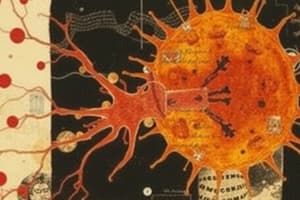Podcast
Questions and Answers
In a patient experiencing atrophy due to prolonged immobilization, which of the following best describes the cellular change occurring?
In a patient experiencing atrophy due to prolonged immobilization, which of the following best describes the cellular change occurring?
- A decrease in cell size due to loss of subcellular components. (correct)
- The replacement of one adult cell type by another.
- An increase in cell size through synthesis of additional subcellular components.
- An increase in the number of cells in the affected tissue.
A patient with a history of chronic acid reflux develops Barrett's esophagus, where the normal esophageal cells are replaced by cells similar to those lining the intestine. Which cellular adaptation is most likely occurring?
A patient with a history of chronic acid reflux develops Barrett's esophagus, where the normal esophageal cells are replaced by cells similar to those lining the intestine. Which cellular adaptation is most likely occurring?
- Hyperplasia
- Dysplasia
- Atrophy
- Metaplasia (correct)
Why is water deprivation for three or more days potentially fatal?
Why is water deprivation for three or more days potentially fatal?
- It severely disrupts fluid and electrolyte balance, compromising homeostasis. (correct)
- It leads to an isotonic fluid excess, causing cellular swelling.
- It drastically increases potassium levels, leading to cardiac arrest.
- It causes a rapid decrease in blood pressure due to increased blood volume.
A patient with severe heart failure develops significant edema. Which of the following mechanisms is most likely contributing to the edema formation in this patient?
A patient with severe heart failure develops significant edema. Which of the following mechanisms is most likely contributing to the edema formation in this patient?
A patient is admitted with pulmonary edema. Auscultation of breath sounds is performed. Which of the following findings is most consistent with pulmonary edema?
A patient is admitted with pulmonary edema. Auscultation of breath sounds is performed. Which of the following findings is most consistent with pulmonary edema?
A patient presents to the emergency department with dehydration due to severe vomiting and diarrhea. Which of the following findings would you most expect to observe?
A patient presents to the emergency department with dehydration due to severe vomiting and diarrhea. Which of the following findings would you most expect to observe?
A patient with cirrhosis develops ascites and is hyponatremic despite having a normal total body water. Which of the following is the most likely underlying mechanism for the hyponatremia in this patient?
A patient with cirrhosis develops ascites and is hyponatremic despite having a normal total body water. Which of the following is the most likely underlying mechanism for the hyponatremia in this patient?
A patient with chronic kidney disease presents with muscle weakness and cardiac dysrhythmias. Lab results show a potassium level of 6.2 mEq/L. Which of the following is the most likely cause of these findings?
A patient with chronic kidney disease presents with muscle weakness and cardiac dysrhythmias. Lab results show a potassium level of 6.2 mEq/L. Which of the following is the most likely cause of these findings?
A patient with a history of alcoholism is admitted to the hospital. Lab results reveal hypocalcemia. Which of the following mechanisms is most likely contributing to the development of hypocalcemia in this patient?
A patient with a history of alcoholism is admitted to the hospital. Lab results reveal hypocalcemia. Which of the following mechanisms is most likely contributing to the development of hypocalcemia in this patient?
A patient with chronic kidney disease is taking magnesium-containing antacids. Which electrolyte imbalance are they at risk for?
A patient with chronic kidney disease is taking magnesium-containing antacids. Which electrolyte imbalance are they at risk for?
Flashcards
Pathophysiology
Pathophysiology
The study of altered bodily functions due to disease, from the Greek words 'pathos' (suffering) and 'physis' (form).
Atrophy
Atrophy
Decrease in cell size due to loss of subcellular components, in an attempt to cope with unfavorable conditions.
Hyperplasia
Hyperplasia
An increase in the number of cells within a tissue or organ.
Metaplasia
Metaplasia
Signup and view all the flashcards
Edema
Edema
Signup and view all the flashcards
Isotonic Fluid Deficit
Isotonic Fluid Deficit
Signup and view all the flashcards
Hypertonic Fluid Deficit
Hypertonic Fluid Deficit
Signup and view all the flashcards
Hypotonic Fluid Deficit
Hypotonic Fluid Deficit
Signup and view all the flashcards
SIADH
SIADH
Signup and view all the flashcards
Hypokalemia
Hypokalemia
Signup and view all the flashcards
Study Notes
Pathophysiology Overview
- Pathophysiology studies altered bodily functions due to disease.
- "Pathos" (suffering) and "physis" (form) are its Greek roots.
- Diseases emerge when cells, tissues, and organs fail to maintain homeostasis under stress.
Cellular Adaptation
- Cells and tissues adapt to shield themselves from damage due to adverse conditions.
- Adaptations can be either permanent or temporary.
- Atrophy involves a decrease in cell size due to losing subcellular components.
- The number of cells stays constant.
- It's an attempt to cope with unfavorable conditions or disuse.
- Hypertrophy is the increase in cell size through synthesis of additional subcellular components.
- Hyperplasia involves an increase in the number of cells within a tissue or organ.
- Dysplasia includes variations in cell size, shape, and organization.
- It's often found in epithelial cells with atypical changes.
- Metaplasia is a reversible adaptation where one adult cell type is replaced by another.
Fluid and Electrolyte Balance
- Biochemical reactions require an aqueous environment in the body.
- Disruptions in fluid and electrolyte balance can instigate or worsen diseases.
- Imbalances arise from excessive fluid output or input.
- Examples include profuse sweating, salt intake, or dehydration.
- Water deprivation for three or more days could be fatal.
- The degree of fluid imbalance impacting homeostasis depends on size, age, and underlying conditions.
- A loss of 30% of total body fluid could compromise homeostasis in a healthy adult.
- A loss of only 10-15% of total body fluid could compromise homeostasis in a small child.
- Fluid therapy is a crucial step in resuscitation.
Edema
- Edema is accumulation of fluid in interstitial spaces.
- Increased capillary hydrostatic pressure, perhaps from venous obstruction, can be a cause.
- Edema can occur with an increased vascular volume.
- Adrenocortical hormones, pregnancy, and environmental heat stress can induce edema too.
- Prolonged standing increases the effects of gravity resulting in edema too.
- Decreased colloid osmotic pressure in capillaries occurs via plasma protein loss.
- Lymphatic vessel obstruction from infection, disease, or removal can cause edema.
- Peripheral edema in ankles and feet is common.
- Sacral edema often occurs in bedridden patients.
- Ascites refers to fluid accumulation in the peritoneal cavity, also deemed edema.
Clinical Manifestations and Assessment of Edema
- Edema can be localized or widespread.
- Pulmonary edema may occur in cardiac patients or those falling due to submersion.
- Narcotic overdoses or high altitude pulmonary edema (HAPE) are also causes.
- Pulmonary Edema assessment should include auscultation of breath sounds, assessment of sacral edema, and jugular venous distention (JVD).
- Diagnostic tools incorporate ECG and vital signs monitoring.
- Medical history, including current and past medications, is crucial.
- Treatment mirrors the patient's chief complaint and presenting problem.
- Interventions involve CPAP, supplemental oxygen, or positional therapy.
- Nitrates and diuretics often have a role in hospitals.
Isotonic Fluid Imbalances
- Isotonic fluid deficit: extracellular fluid loss disproportionate to sodium and water levels.
- Common via vomiting, diarrhea, plasma or blood loss (burns, hemorrhage).
- Loop diuretics, fever, reduced fluid intake, and excessive sweating also play a part.
- Comorbidities with physical exertion can exacerbate fluid loss.
- Isotonic fluid excess means a proportionate increase in both sodium and water in extracellular fluid.
- Causes: heart failure, liver cirrhosis, renal failure, steroids, or excess sodium intake.
- Dehydration leads to orthostatic hypotension and decreased urine output (oliguria).
- High sodium levels increase risk of delirium and coma.
Electrolyte Imbalances: Sodium (Na+)
- Sodium (Na+) is vital for fluid balance, total fluid volume, and blood pressure regulation.
- Sodium facilitates muscle contraction and nerve impulse transmission
- Normal sodium level: 136–142 mEq/L.
- Abnormalities: nausea, weakness, confusion, and seizures.
- Hypertonic fluid deficit: water loss occurs without proportionate sodium loss which can cause hypernatremia.
- Sodium level exceeds 143 mEq/L.
- Hypotonic fluid deficit: sodium loss exceeds water loss - can cause hyponatremia.
- Serum sodium level falls below 135 mEq/L.
- Causes: heart failure, cirrhosis, renal failure.
- Syndrome of inappropriate antidiuretic hormone (SIADH) can also cause this
- Normal fluid volume with hyponatremia can be caused by SIADH.
- Symptoms: fatigue, loss of appetite, nausea, muscle cramps, weakness, abdominal discomfort, headaches, confusion, seizures.
- Medical findings depend on the sodium level, as well as, how the abnormality developed.
- The more acute the sodium level change, the more intense the symptoms.
Electrolyte Imbalances: Potassium (K+)
- Potassium (K+) regulates acid-base balance, muscle control, enzyme reactions, and osmolarity.
- Normal potassium levels: 3.5–5 mEq/L.
- Hypokalemia is the lack of potassium.
- Common through decreased intake/absorption, potassium shifting into cells, renal/external losses.
- Symptoms: muscle weakness, fatigue, cramping, ascending paralysis.
- Can be fixed with IV potassium and supplements.
- Hyperkalemia is elevated potassium level.
- Common via decreased excretion (kidney failure/medications), potassium shifts from within cells, dietary intake.
- Interferes with neuromuscular function causing fatigue, nausea, muscle weakness, altered sensations, ascending paralysis.
- ECG reflects cardiac dysrhythmias.
Electrolyte Imbalances: Calcium (Ca2+)
- Calcium is essential for bone and teeth strength and stability.
- Calcium enters through the gastrointestinal tract.
- Calcium depends on the presence of vitamin D
- Calcium is stored in bone tissue and excreted by the kidney
- Normal Calcium level: 8.2–10.2.
- Hypocalcemia is caused by decreased intake or absorption (lack of vitamin D), increased loss (alcoholism, diuretics), endocrine disease, sepsis.
- Symptoms: muscle spasms, cramping, seizures, altered sensations, dysrhythmias observed on ECG.
- Hypercalcemia comes from increased intake/absorption (excess antacid use), endocrine disorders (adrenal insufficiency), neoplasms.
- Symptoms: fatigue, weakness, nausea, constipation, frequent urination (polyuria) occur.
- Treatment addresses the underlying cause
Electrolyte Imbalances: Phosphate (PO43-)
- Phosphate is an intracellular ion.
- Phosphate levels are regulated by the same mechanisms as calcium.
- Normal level: 2.3–4.7.
- Hypophosphatemia is caused by a lack of absorption.
- Excessive loss in those with hyperparathyroidism or alcoholism also result in this
- It can occur after glucose or anabolic steroid administration.
- Abnormal loss of nutrients followed by inadequate replenishment in patients with diabetic ketoacidosis or chronic alcoholism also cause it.
- Symptoms: dysrhythmias, hypotension, muscle weakness, altered mental status, breakdown of muscle fibers, loss of appetite, tremors, seizures, coma, susceptibility to infection.
- Hyperphosphatemia can happen via excessive vitamin D or laxative/enema use
- Vitamin D and laxatives can cause this
- Metabolic acidosis and decreased excretion into the urine can also happen with acromegaly
- Symptoms: tremors, overactive reflexes, confusion, seizures, muscle weakness, hypotension, heart failure, prolonged QT interval.
Electrolyte Imbalances: Magnesium (Mg2+)
- Magnesium is in the top intracellular cations.
- Normal range: 1.3–2.1.
- Hypomagnesemia can occur from diminished absorption/intake (alcohol use, malabsorption, malnutrition), renal losses (diuretics, chronic kidney disease), GI loss (diarrhea, vomiting).
- Symptoms: weakness, muscle cramps, CNS issues, tremors, insomnia, personality changes, hypertension/tachycardia, dysrhythmias, confusion.
- Hypermagnesemia occurs with kidney insufficiency and insufficient excretion.
- Symptoms: muscle weakness, decreased reflexes, altered mentality, dysrhythmias, paralysis, cardiac arrest.
Studying That Suits You
Use AI to generate personalized quizzes and flashcards to suit your learning preferences.




